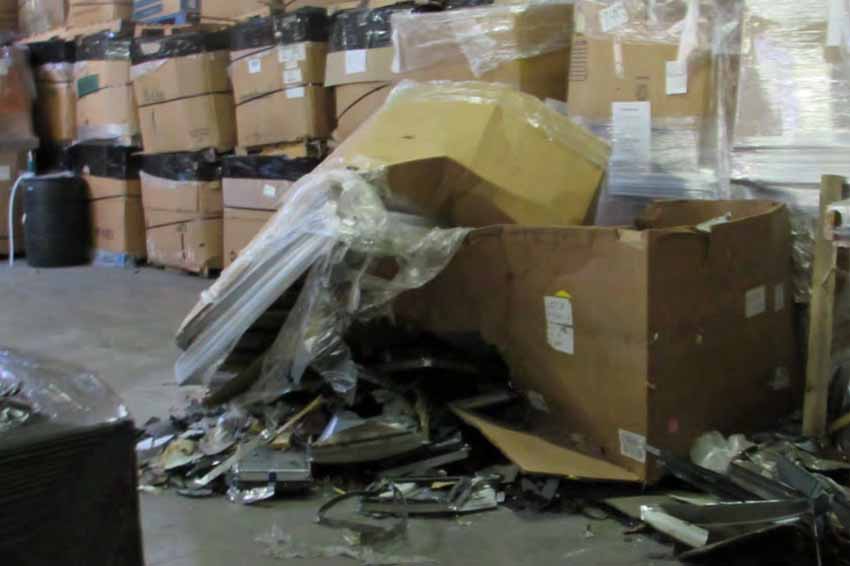
Sony’s payment will help fund cleanup of the estimated 160 million pound stockpile at two Ohio facilities. | Courtesy of EnSafe.
Sony Electronics agreed to pay $1.2 million to settle allegations that the company is liable for CRT materials abandoned by Closed Loop Refining and Recovery.
The San Diego-based OEM reached a legal agreement with Garrison Southfield Park and Olymbec USA, landlords that leased warehouses in Columbus, Ohio to Closed Loop.
Closed Loop failed in 2016, leaving an estimated 128 million pounds at Garrison Southfield Park’s two adjacent facilities and about 30 million pounds at Olymbec USA’s warehouse. Cleanup is underway.
In August 2020, the landlords sued nine electronics manufacturers – ASUS Computer International, Dell Technologies, Haier America, LG Electronics USA, Micro Center, Premio, Samsung Electronics America, Sony Electronics, Westinghouse Digital – and one stewardship group: Electronic Manufacturers Recycling Management Co. (MRM), which fulfills legally mandated collection and recycling programs in 20 states on behalf of manufacturers.
Sony is the first OEM to settle and agree to help fund the CRT cleanup. Two OEMs, Dell and Micro Center, have filed defenses and counterclaims against the landlords, and other manufacturers haven’t yet responded in court.
When they were named in the lawsuit, the OEMs joined a long list of existing defendants in the federal district court case. In March 2019, Garrison Southfield Park and Olymbec USA filed a lawsuit against dozens of e-scrap companies that shipped CRTs to Closed Loop in Ohio.
Since then, 25 e-scrap defendants have reached settlements totaling over $3.1 million. Eleven other e-scrap companies continue to defend themselves in court, with some leveling their own claims against the landlords. Another seven companies have gone out of business or failed to appear in court.
Sony reaches agreement
Sony’s settlement was submitted to the U.S. District Court for the Southern District of Ohio on Nov. 11. Sony’s vice president of North America Customer Service, Timothy McGowan, who oversees e-scrap recycling programs, signed it on Sept. 25.
If approved by the judge, the agreement obligates Sony to pay $1.2 million to fund removal and remediation of about 5.5% of the approximately 160 million pounds at the facilities. The judge overseeing the case hasn’t rejected any of the previous settlements.
To date, the e-scrap companies’ settlement amounts have been calculated based on the amount of material they shipped to Closed Loop (although not all settling defendants have been obligated to pay for 100% of what they shipped). Most of the settlement payments have equaled about 14 cents per pound they shipped to Closed Loop.
To calculate Sony’s payment amount, the parties looked at Sony’s market share, rather than estimates of pounds shipped. In court documents, the attorney for Sony and the landlords explained why.
In a motion to approve the deal, the plaintiffs argue the OEMs are legally responsible for cleanup partly because of their participation in state extended producer responsibility (EPR) laws, which obligate OEMs to help fund e-scrap collection and recycling if they want to sell their products in that state. Each OEM’s obligation is generally based on their market share.
“Consideration of an OEM’s market share therefore aligns with Plaintiffs’ theory of liability, which rests in part on the allegation that OEMs exert market power and influence by virtue of state EPR laws,” according to a declaration submitted by Sony’s attorney, Scott Furman.
In written declarations, Furman and Karl Heisler, attorney for Garrison Southfield Park, also explained that it would be “exceedingly difficult to ascribe specific weights of e-waste at the Facility to specific OEMs with any reasonable degree of certainty.” In many cases, OEMs contract with a company to ship e-scrap to one location, where disassembly takes place. Then, residuals, such as CRT glass, are transported by other parties to other locations.
“The bill of lading for any given load of E-Waste transported to the Facility, for example, does not identify whether any OEM claimed EPR credit for all or a part of that shipment, making it difficult to attribute individual shipments of E-Waste to any particular OEM,” the declarations both state.
Further complicating any analysis is the fact that OEMs “buy” weight, not full loads, for purposes of meeting their obligations, the attorneys both noted. As a result, any particular load and its bill of lading can include a commingling of OEM-funded e-scrap with non-OEM-funded e-scrap.
Based on numbers presented in the settlement, Sony’s payment would be on par with most other settling parties’ payments. A $1.2 million payment to compensate for 5.5% of the stockpile (or about 8.8 million pounds of the estimated total 160 million pounds) comes out to nearly 14 cents a pound.
Manufacturers’ differing responses
Heisler’s declaration noted that Sony showed “commitment from the outset of settlement negotiations to participate in the funding of cleanup activities” and that it is still cooperating with the plaintiffs.
At least two other OEMs appear set to fight in court.
Round Rock, Texas-based Dell filed an answer to the lawsuit on Nov. 10, and Hilliard, Ohio-headquartered Micro Center filed its response on Oct. 27. Both companies cited a number of reasons why they believe they’re not legally responsible. They each pointed fingers at the landlords.
“Any costs or damages complained of by Plaintiff were due to its own failure as the owner of the property to exercise proper and prudent care, including but not limited to permitting Closed Loop to operate on its property without reasonable prudent controls or inspections,” according to Dell. “As between Dell and Plaintiff, Plaintiff was in a better position to control the actions of its tenant, Closed Loop, in this regard.
More stories about courts/lawsuits
- Closed Loop companies hit with $3 million in Ohio penalties
- More processors settle in Iowa CRT stockpile case
- Guilty pleas in surplus equipment disposal scheme